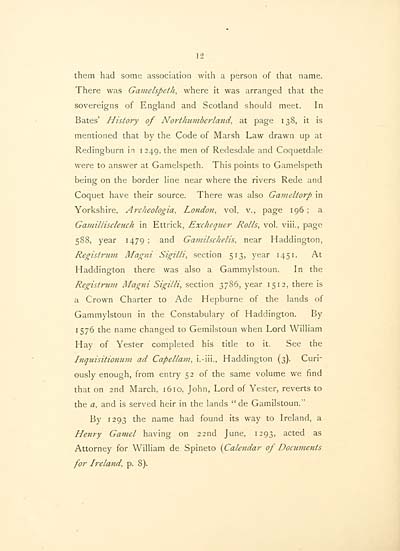Notes on the probable origin of the name Gemmill or Gemmell
(16) Page 12 - Early bearers of the name in Ireland
Download files
Complete book:
Individual page:
Thumbnail gallery: Grid view | List view

12
them had some association with a person of that name.
There was Gamelspeth, where it was arranged that the
sovereigns of England and Scotland should meet. In
Bates' History of Northumberland, at page 138, it is
mentioned that by the Code of Marsh Law drawn up at
Redingburn in 1249, the men of Redesdale and Coquetdale
were to answer at Gamelspeth. This points to Gamelspeth
being on the border line near where the rivers Rede and
Coquet have their source. There was also Gameltorp in
Yorkshire, Archeologia, London, vol. v., page 196 ; a
Gamilliscleuch in Ettrick, Exchequer Rolls, vol. viii., page
588, year 1479 ; and Gamilschelis, near Haddington,
Registruni Magni Sigilli, section 513, year 145 1. At
Haddington there was also a Gammylstoun. In the
Registruni Magni Sigilli, section 3786, year 15 12, there is
a Crown Charter to Ade Hepburne of the lands of
Gammylstoun in the Constabulary of Haddington. By
1576 the name changed to Gemilstoun when Lord William
Hay of Yester completed his title to it. See the
Inquisitionum ad Capellam, i.-iii., Haddington (3). Curi-
ously enough, from entry 52 of the same volume we find
that on 2nd March, 1610, John, Lord of Yester, reverts to
the a, and is served heir in the lands " de Gamilstoun."
By 1293 the name had found its way to Ireland, a
Henry Gamel having on 22nd June, 1293, acted as
Attorney for William de Spineto {Calendar of Documents
for Ireland, p. 8).
them had some association with a person of that name.
There was Gamelspeth, where it was arranged that the
sovereigns of England and Scotland should meet. In
Bates' History of Northumberland, at page 138, it is
mentioned that by the Code of Marsh Law drawn up at
Redingburn in 1249, the men of Redesdale and Coquetdale
were to answer at Gamelspeth. This points to Gamelspeth
being on the border line near where the rivers Rede and
Coquet have their source. There was also Gameltorp in
Yorkshire, Archeologia, London, vol. v., page 196 ; a
Gamilliscleuch in Ettrick, Exchequer Rolls, vol. viii., page
588, year 1479 ; and Gamilschelis, near Haddington,
Registruni Magni Sigilli, section 513, year 145 1. At
Haddington there was also a Gammylstoun. In the
Registruni Magni Sigilli, section 3786, year 15 12, there is
a Crown Charter to Ade Hepburne of the lands of
Gammylstoun in the Constabulary of Haddington. By
1576 the name changed to Gemilstoun when Lord William
Hay of Yester completed his title to it. See the
Inquisitionum ad Capellam, i.-iii., Haddington (3). Curi-
ously enough, from entry 52 of the same volume we find
that on 2nd March, 1610, John, Lord of Yester, reverts to
the a, and is served heir in the lands " de Gamilstoun."
By 1293 the name had found its way to Ireland, a
Henry Gamel having on 22nd June, 1293, acted as
Attorney for William de Spineto {Calendar of Documents
for Ireland, p. 8).
Set display mode to:
![]() Universal Viewer |
Universal Viewer | ![]() Mirador |
Large image | Transcription
Mirador |
Large image | Transcription
Images and transcriptions on this page, including medium image downloads, may be used under the Creative Commons Attribution 4.0 International Licence unless otherwise stated. ![]()
| Histories of Scottish families > Notes on the probable origin of the name Gemmill or Gemmell > (16) Page 12 - Early bearers of the name in Ireland |
|---|
| Permanent URL | https://digital.nls.uk/95561189 |
|---|
| Description | A selection of almost 400 printed items relating to the history of Scottish families, mostly dating from the 19th and early 20th centuries. Includes memoirs, genealogies and clan histories, with a few produced by emigrant families. The earliest family history goes back to AD 916. |
|---|

